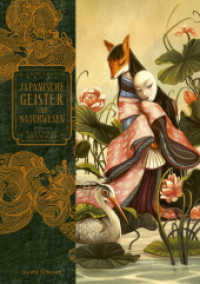基本説明
This volume is organized not in the predictable linear framework, by periods and centuries, but rather by the realization that throughout much of this period, Spanish authorities and others envisaged the Spanish colonies of the Americas in genedered terms.
Full Description
This anthology centers on the visual representation of woman in early modern Latin America, that is, the social and cultural construction and definition of female identity as evidenced by the art document. Artists in this period were collectively aware of a vocabulary of gender that could be tailored to deliver varying messages about the position of women in vice regal culture and society.
This volume is organized not in the predictable linear framework, by periods and centuries, but rather by the realization that throughout much of this period, Spanish authorities and others envisaged the Spanish colonies of the Americas in gendered terms. Proffered as the female body, the "New" (virginal by implication) World was at differing times adored, pursued, courted, seduced, defiled, exploited, reviled, and denounced by those (males) who encountered "her." This mentality is born out in the various forms of female representation that are discussed in this fully illustrated book.
Contributors include: C. Cody Barteet, María Elena Bernal-García, Magali M. Carrera, Carol E. Damian, Carolyn Dean, Catherine R. DiCesare, Lori Boornazian Diel, Kelly Donahue-Wallace, Ray Hernandez-Duran, Andrea Lepage, Kellen Kee McIntyre, Penny Morrill, Elizabeth Q. Perry, Richard E. Phillips, Michael J. Schreffler, and Christopher C. Wilson.
ERRATUM TO CHAPTER 7
Ray Hernández-Durán, "El Encuentro de Cortés y Moctezuma: The Betrothal of Two Worlds in Eighteenth-Century New Spain" (pp. 181-206).
On page 194, second paragraph, third sentence, should read:
"Marina's absence in the encounter painting, where she normally mediates contact between the men, emphasizes the phallogocentric aspect of the historic meeting."
The original phrasing, using the pivotal term, 'phallogocentric' (a reference to a gendered form of exchange or communication) was changed to 'phallus-centered,' which not only alters a central idea in the argument, but actually has nothing to do with the image in question.
Contents
Acknowledgments, List of Illustrations
Introduction, Kellen Kee McIntyre
Part I. RECONNAISSANCE: MARKING AND MAPPING THE NEW WORLD WITH THE FEMALE BODY
Chapter One. The Queen of Heaven Reigns in New Spain: The Triumph of Eternity in the Casa del Deán Murals, Penny C. Morrill
Chapter Two. Affections of the Heart: Female Imagery and the Notion of Nation in Nineteenth-Century Mexico, Magali M. Carrera
Chapter Three. The Virgin of the Andes: Inka Queen and Christian Goddess, Carol Damian
Chapter Four. Women and Men as Cosmic Co-Bearers at Oaxtepec, Mexico, about 1553, Richard E. Phillips
Part II. TAKING POSSESSION: APPROPRIATIONS OF THE NEW WORLD/FEMALE BODY
Chapter Five. Abused and Battered: Printed Images and the Female Body in Viceregal New Spain, K. Donahue-Wallace
Chapter Six. Reclaiming Tlatilco's Figurines from Biased Analysis, María Elena Bernal-García
Chapter Seven. El encuentro de Cortés y Moctezuma: The Betrothal of Two Worlds in Eighteenth-Century New Spain, Ray Hernández-Durán
Chapter Eight. Nurture and Inconformity: Arrieta's Images of Women, Food, and Beverage, Jenny O. Ramírez
Part III. CONSOLIDATION: THE QUALIFYING AND TAMING OF THE NEW WORLD/FEMALE BODY WITH SIGNIFIEDS
Chapter Nine. Clothing Women: The Female Body in Pre- and Post-Contact Aztec Art, Lori Boornazian Diel
Chapter Ten. Savage Breast/Salvaged Breast: Allegory, Colonization, and Wet-Nursing in Peru, 1532-1825, Carolyn Dean
Chapter Eleven. Emblems of Virtue in Eighteenth-Century New Spain, Michael J. Schreffler
Chapter Twelve. The Figure of Mary as the Cloister in Mexican Mendicant Art, Richard E. Phillips
Part IV. FULFILLMENT: THE EXTENSION AND EXPRESSION OF THE FEMALE BODY IN THE NEW WORLD
Chapter Thirteen. Convents, Art, and Creole Identity in Late Viceregal New Spain, Elizabeth Perry
Chapter Fourteen. The Sweeping of the Way: Rethinking the Mexican Ochpaniztli Festival, Catherine R. DiCesare
Chapter Fifteen. Exploring a Female Legacy: Beatriz Álvarez de Herrera and the Façade of the Casa de Montejo, C. Cody Barteet
Chapter Sixteen. Isabel de Cisneros in Her Own Role, A. Lepage
Chapter Seventeen. From Mujercilla to Conquistadora: St. Teresa of Ávila's Missionary Identity in Mexican Colonial Art, Christopher C. Wilson
Index






